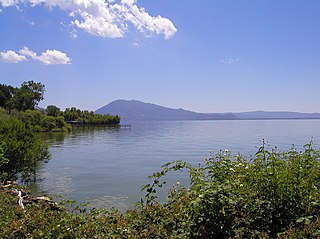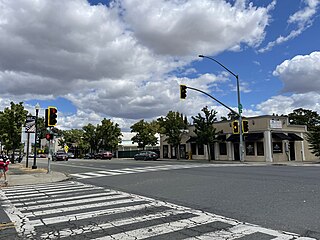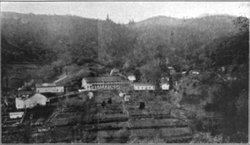
Lake County is a county located in the north central portion of the U.S. state of California. As of the 2020 census, the population was 68,163. The county seat is Lakeport. The county takes its name from Clear Lake, the dominant geographic feature in the county and the largest non-extinct natural lake wholly within California.

Middletown is a census-designated place (CDP) in Lake County, California, United States. Its population was 725 at the 2020 census down from 1,323 at the 2010 census, which was up slightly from 1,020 at the 2000 census. Middletown was given its name because it is halfway between Lower Lake and Calistoga, which is 17 miles (27 km) to the south. The town was severely damaged by the 2015 Valley Fire.

Hot Sulphur Springs is a statutory town and the county seat of Grand County, Colorado, United States. The town is located near Byers Canyon between Granby and Kremmling, 95 miles (153 km) northwest of Denver and 30 miles (48 km) northwest of Winter Park. The town population was 687 at the 2020 census. Its elevation is 7,680 feet (2,340 m).

Wilbur Hot Springs is a naturally occurring historic hot spring, health sanctuary, personal retreat and 1,800-acre (7.3 km2) nature reserve 20+ miles west of Williams, Colusa County, in northern California. It is about 2 hours northeast of the San Francisco Bay Area and 1½ hours north of the Sacramento Airport.

Castle Rock Springs was a resort Lake County, California built around a group of mineral springs, including one hot spring with relatively high volumes of water.

Howard Springs is a set of springs turned into a resort in the 1870s in Lake County, California. The resort catered primarily to people interested in the curative powers of the mineral waters. Guests were accommodated in cabins or tents. At one time it had an official post office. The resort changed hands many times over the years, with various changes to the lodge, accommodations and bathhouses, until closing in 1970. For a period it was leased for geothermal exploration. Today it has reopened as a health resort.

Seigler Springs is a set of springs in Lake County, California around which a resort developed in the 19th century. In the 1930s the resort was expanded, and in 1947 an airport opened nearby. The resort declined in the 1960s. Part of it was separated out and became a residential subdivision, while part became a religious retreat. The 2015 Valley Fire caused great damage.
Campbell Hot Springs is a set of springs in Sierra County, California, United States which was turned into a resort in the 1880s. Campbell Hot Springs is 1.5 miles (2.4 km) southeast of Sierraville. The community was founded as a thermal springs resort in the 1880s.
Harold Dull (1935—2019) was an American aquatic bodyworker and poet best known as the creator of Watsu, originally developed in the early 1980s at Harbin Hot Springs, California. He is also known for his poetry, as founder of the Worldwide Aquatic Bodywork Association (WABA), and as creator of Tantsu and Tantsuyoga. Watsu is a form of aquatic bodywork in which a practitioner or therapist gently cradles, moves, stretches, and massages a receiver in chest-deep warm water for deep relaxation and aquatic therapy.

Bimini Baths was a geothermal mineral water public bathhouse and plunge in what is now Koreatown, Los Angeles, California, US. It was situated just west of downtown, near Third Street and Vermont Avenue. Bimini Baths contained a natatorium, swimming pools, swimming plunge, Turkish baths, a medical treatment department, and bottling works.

Faywood Hot Springs,, are thermal springs in Grant County, New Mexico, United States. It is located 2 miles (3.2 km) northeast of US 180 and .5 miles (0.80 km) west of NM 61, just south of the City of Rocks State Park. The hot springs have been visited since the time of the Mimbres culture. It was a successful resort in the late 19th century and early 20th century. In 1952, the establishment was demolished and became a ghost town. The land was purchased in 1993 and developed into a hot springs resort again.

The Valley Fire was a wildfire during the 2015 California wildfire season that started on September 12 in Lake County, California. It began shortly after 1:00 pm near Cobb with multiple reports of a small brush fire near the intersection of High Valley and Bottlerock Roads. It quickly spread and by 6:30 PM PDT, it had burned more than 10,000 acres (40 km2). By Sunday, the thirteenth of September, the fire had reached 50,000 acres (202 km2) and had destroyed much of Cobb, Middletown, Whispering Pines, and parts in the south end of Hidden Valley Lake. The fire ultimately spread to 76,067 acres (308 km2), killed four people and destroyed nearly 2,000 buildings, before it was fully contained on October 15, 2015, causing at least $921 million in insured property damage. At the time, the fire was the third-most destructive fire in California history, based on the total structures burned, but the Camp Fire (2018) and the North Complex fire in 2020, exceeded that total.
Anderson Springs is a set of hot springs and a resort in Lake County, California. It is located at an elevation of 1411 feet.

Wheeler Springs is an unincorporated community that grew around a set of sulphurated hot springs in Ventura County, California. It is located 6 miles north of the Ojai Valley, within Los Padres National Forest. It is named for Wheeler Blumberg, who founded the town in 1891, and the many natural hot springs.

The Point Arena Hot Springs are hot springs located along the Garcia River, 15 miles southeast of Point Arena in Mendocino County, California, in the United States. The hot springs served as a popular resort in the late 19th and early 20th centuries. In 1913, the California Blue Book described the Point Arena Hot Springs as "one of California's most beautiful health resorts." The Point Arena Hot Springs reside within private timber company property, and are no longer legally accessible to the public.

Baker Hot Springs are a system of geothermal springs located on Fumarole Butte, northwest of the town of Delta, Utah. The springs were formerly known as Crater Springs and Abraham Hot Springs.

Matilija Hot Springs is a thermal spring system of 22 hot and cold springs, and is a former resort located northwest of the town of Ojai, California. The site was designated a Ventura County Historical Landmark (#25) in 1972.

White Sulphur Springs was considered the oldest warm mineral springs resort facility in Northern California. It was founded in 1852 in the town of St. Helena in the Napa Valley. Most of the structures at the site were destroyed in 2020 in the Glass Fire.

















